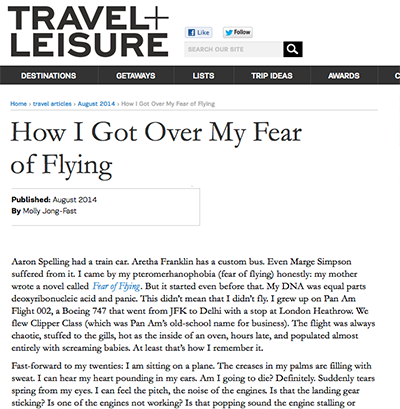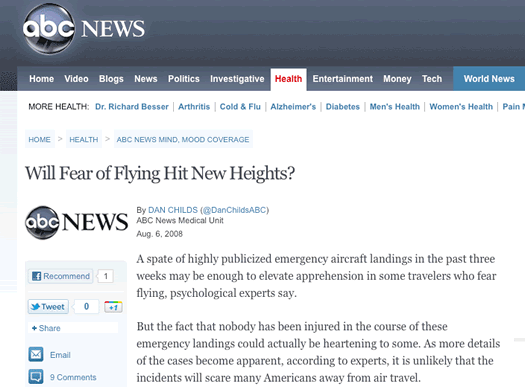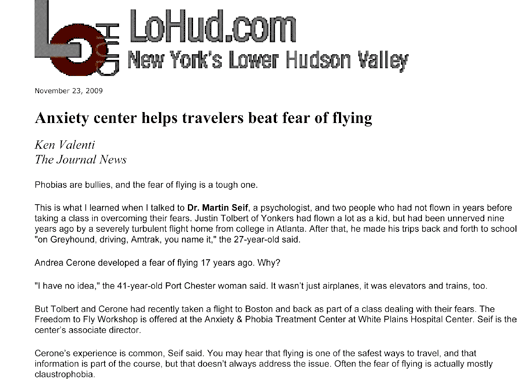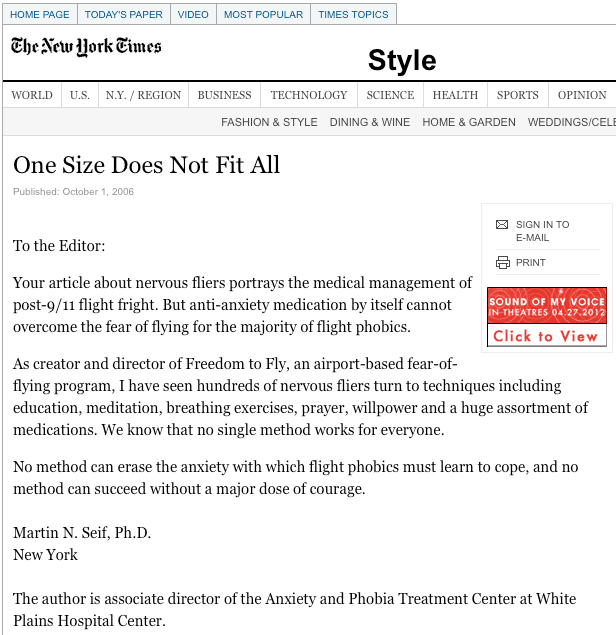Dr. Martin Seif is currently not accepting any new patients. Please click here for information on self help and finding appropriate therapists
Don’t Let Your Fears Keep You Grounded!
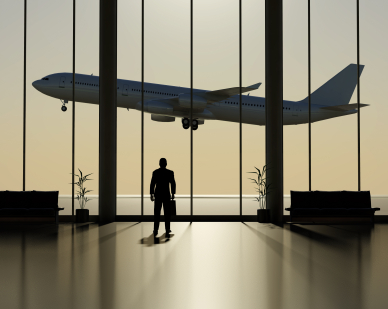
It is estimated that one out of every five Americans are afraid to fly. If you are afraid to fly, you can overcome this fear and become a comfortable traveler.
Imagine how great your life could be if you looked forward to vacations, rather than dreading the anticipated flight. How many of you have passed up promotions and job opportunities because of your terror of flying?
Dr. Marty Seif is one of the nation’s most experienced specialists in the treatment of flying phobias. He has personally seen more people with fear of flying than any other anxiety treatment specialist in the United States.
Fear of Flying is a term that describes a variety of phobias. You will do best if you find someone who is an expert in “Fear of Flying” specifically. That’s because fear of flying is really a confluence of many different fears. A much better term would be “fears of flying.” Think of an airplane as the perfect storm for anxieties
Here is a segment of the book by Dr. Marty Seif (co-authored with Dr. Sally Winston), What Every Therapist Needs to Know About Anxiety Disorders (Rutledge, 2014), that goes into the reason why details make such a huge difference in treating Fear of Flying.
Flight 702 from New York to Los Angeles has boarded. Six frightened fliers are seated in row 17, seats A through F. Each responds “yes” to the following four questions.
1 – Are you afraid to fly?
2 – Are you anxious anticipating a flight?
3 – Would you prefer to avoid flying if you can?
4 – Are you feeling anxious right now?
In seat 17A, the passenger is thinking “I don’t know if I can stand it when the doors close. I am going to feel trapped, I won’t be able to leave, I am going to get that unbearable overwhelming rapid heart rate and I won’t be able to breathe right and I don’t know if I can control my reaction and I could just either go crazy or even cause myself a heart attack. Are there strait jackets in case I lose control? What if I lose it and open the door in the middle of the flight? I wonder if there is a defibrillator on the plane.”
This person has panic disorder. He is terrified of panicking while on the plane, and his fear of flying is a fear of experiencing a panic attack.
Seat 17B is occupied by someone who feels sensations similar to the first person–rapid heart rate, difficulty breathing– but the cognitive focus is interpersonal rather than intrapsychic. He is thinking “I am getting anxious and I feel like I might throw up and get pale and fidgety and the person next to me is going to turn to me and say ‘are you alright?’ and what if I can’t talk properly and by the time we get to our destination, everyone in the plane will know there is a nutcase on this plane. I don’t know if I can keep my anxiety hidden. And what if a flight attendant comes over to try to help me–then everyone in this whole plane will be focusing on me and wondering what is going on. What if I start to look weird and crazy to them? What if someone thinks I am a terrorist?”
This person is not primarily afraid of the anxious feelings, but of the fact that they could show and someone will judge him badly, exposing him to humiliation, inadequacy, and shame. This person’s fear of flying is an aspect of his social anxiety disorder.
In seat 17 C is someone who is also incredibly upset with the following thoughts:” I know that they clean the planes in a deep way with antibacterial solution every two weeks and that they spray room freshener into the air when they are on the ground because I did the research, but in between flights, they just pick up the trash. I have really been trying to keep my arms and hands off the seat rest because you never know who was sitting here and what germs they could have — it could even be AIDS — and they are only 99% sure that it can’t be transmitted this way and you can’t be sure that this passenger did not have an open wound on their hand anyway. And all of a sudden I am thinking that I may have inadvertently touched the armrest when I was listening to the pilot announcement and OMG what if I get sick and transmit it to my kids? And how about that virus that is going around? I’m trying not to breathe too deeply on this plane, because the inside of the cabin is just one big incubator of germs, and I don’t want them inside of me.“
This person, who in former times might have been incorrectly labeled “germophobic,” suffers from OCD. In repeated attempts to lower her anxiety, she keeps trying to reassure herself and to tell herself over and over that she is overreacting. This self-talk, which comforts her only partially and only for a short time, is called cognitive compulsions. While the idea of the plane crashing (and other dangerous possibilities) may also scare her, right now she is focused on the possibility that being on this flight might harm herself and her children.
In the next seat over, Seat 17 D, sits someone whose older brother went down in a plane in Vietnam when she was a child. Every time she has to fly, she has weeks of dreams about fiery crashes, reliving that horrible moment when her mother told her that her brother was dead. She is hyperventilating right now; feels overwhelmed with fear and grief and would rather be anywhere else. Half of her is presently on the plane and half of her is in the past.
For this person, flying triggers intensely painful memories of her previous trauma–memories that come alive, feel like real-life, and crowd out the present when she encounters triggers connected to them. This woman suffers from post-traumatic stress disorder.
Seat 17 E is occupied by someone worried about the plane crashing and whether or not the pilot has a hangover, and whether or not that rattling sound underneath her seat is normal. But she is also worried that she may have a scratchy throat and what if it ruins her vacation, and what if the airline loses her baggage and what if the person who is supposed to pick her up gets stuck in traffic or forgets. And she just learned that she paid more for her ticket than the OCD person in seat 17 C and does that mean she should cancel her plan to go to the expensive restaurant, and–wow– are her muscles going to be sore after sitting for six hours!
This person is in an ongoing and toxic worry state, known as GAD, generalized anxiety disorder, a relentless and rambling set of “what if” worries, which is characterized by –in addition to worry– muscle tension, autonomic arousal, anxious mood, and episodes of panicky feelings.
And finally in seat 17 F is the person with aviophobia—fear of flying—that is a specific phobia (formerly called simple phobia) in which the fear is of an external thing going terribly wrong. This person does not worry as relentlessly as someone with GAD, nor does he obsessively and compulsively check on aspects of his life, like someone with OCD. This person is focused primarily on plane safety, the possibility of weather making his flight more dangerous, how his children might survive his death and the horror of the image of going down during the crash.
This text is meant to illustrate that people who describe themselves as afraid of flying may be suffering from very different disorders. Many people who describe themselves as “afraid to fly” are claustrophobic, and don’t like the idea of being enclosed in the airplane. Others fear heights, turbulence, the idea of crashing, terrorists, flying over water, or traveling long distances.
Treatment is most effective with someone who is experienced with every type of Flight Fright, and who can identify the particular fear(s) that make up your specific fear of flying.
In 2000, Dr. Seif created Freedom to Fly, the preeminent airport-based group program for fearful fliers. Dr. Seif has run Freedom to Fly continuously since that time, and has helped many hundreds of people overcome their fears of flying. In 2016, Dr. Seif concluded this program to concentrate on providing individual help for fearful fliers.
Individual Therapy to Help You Become a Comfortable Flyer
Dr. Marty Seif provides individual treatment, tailored specifically for you, to help you overcome your fears of flying. You might want Dr. Seif to fly with you to help with your initial anticipatory anxieties. If you want just a few “refresher” meetings to make an upcoming flight more comfortable, or if you haven’t flown in years, and need more extensive help, please feel free to contact him.
Download these Documents to Help Yourself Tame the Fear of Flying:
The Thirteen Best Techniques for Controlling Your Anxiety
How To Tame Your Anticipatory Anxiety
Anxiety: An Altered State of Consciousness
Diaphragmatic Breathing: Calming Your Body In Flight
8 Steps to Overcoming Your Fear of Flying
Things That Go Bump On the Flight
Watch
Martin N Seif — January 08, 1999 — Interview with Dr. Martin Seif about fears of flying
New York Times – July 24, 2007 – Freedom To Fly Program
Listen
Radio Interview on Sirius Radio
Dr. Martin Seif talks about Fearful Fliers, Fear of Flying, and how to overcome your fear of flying. Listen Now >>

News Briefs on CBS-880 Radio
In these short interviews, Dr. Marty Seif provides suggestions for making flying more comfortable. Listen Now >>

Interview on Radio Times, WHYY Radio, on “Why We Fear Flying” Listen Now >>
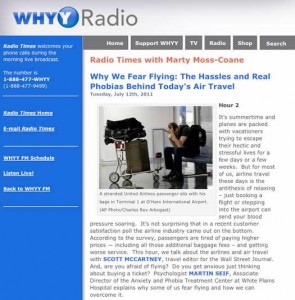
Read
Why Air Travel Is Actually Much Safer Than You Think
by Liz Weiss
US News & World report
Published: Aug. 25, 2016
Flying is one of the safest forms of transportation – believe it or not.
In spite of a series of high-profile incidents making headlines since 2014 – from the AirAsia Flight 8501 tragedy to the disappearance of Malaysia Airlines Flight 370 – air travel safety is improving. According to the International Air Transport Association, in 2015 only 1 in 3.1 million global flights resulted in an airline accident, a 30 percent decrease from flights assessed from 2010-14… Read More>>
Passengers behaving badly: The real reason we freak out on planes.
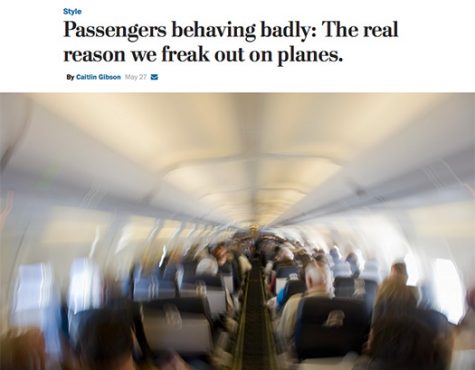
The Washington Post
Published May 2016
By Caitlin Gibson
lanes: They’re where we get drunk. Where we brawl. Where we disable the restroom smoke detectors and light cigarettes. Where we glare at crying children. Where we jam our knees into the backs of the fellow travelers who dare recline their seats. Where we allow our racial paranoia to imagine terrorist threats in the seats around us — a man taking a nap before takeoff, a college student speaking Arabic on the phone, an Ivy League economist scribbling some differential equations on a notepad. Read More>>
Fear of Flying Workshop at Westchester County Airport
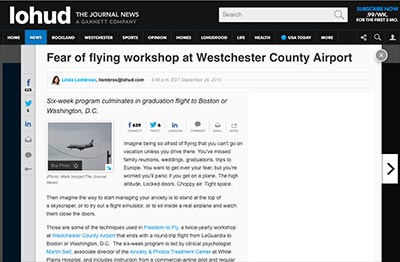 lohud
lohud
Published September 2015
By Linda Lombroso
Imagine being so afraid of flying that you can’t go on vacation unless you drive there. You’ve missed family reunions, weddings, graduations, trips to Europe. You want to get over your fear, but you’re worried you’ll panic if you get on a plane. The high altitude. Locked doors. Choppy air. Tight space. Read More>>
How I Got Over My Fear of Flying
Travel + Leisure
Published August 2014
By Molly Jong-Fast
Aaron Spelling had a train car. Aretha Franklin has a custom bus. Even Marge Simpson suffered from it. I came by my pteromerhanophobia (fear of flying) honestly: my mother wrote a novel called Fear of Flying. Read more>>
Ask The Experts
How can I overcome my fear of flying?
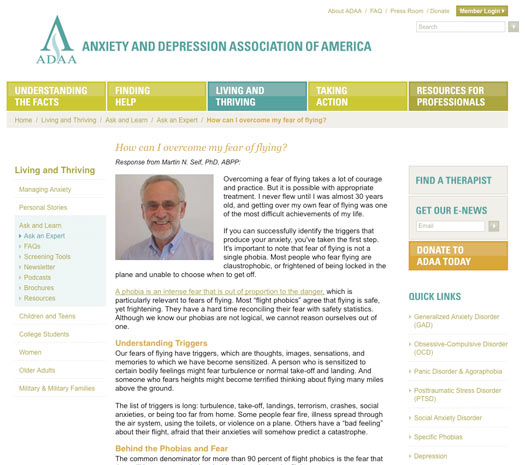
Anxiety and Depression Association of America
Response from Martin N. Seif, PhD, ABPP:
Overcoming a fear of flying takes a lot of courage and practice. But it is possible with appropriate treatment. I never flew until I was almost 30 years old, and getting over my own fear of flying was one of the most difficult achievements of my life. Read More>>
Flying With the Greatest of Ease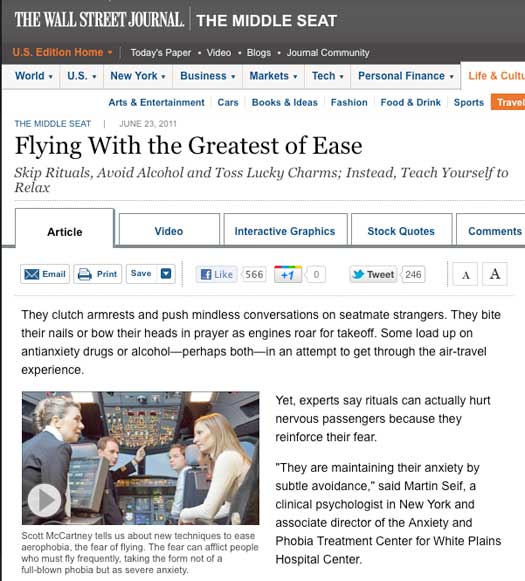 Wall Street Journal – June 23, 2011
Wall Street Journal – June 23, 2011
By Scott McCartney
They clutch armrests and push mindless conversations on seatmate strangers. They bite their nails or bow their heads in prayer as engines roar for takeoff. Some load up on antianxiety drugs or alcohol—perhaps both—in an attempt to get through the air-travel experience. Read More>>
For Flying Phobia, There is Help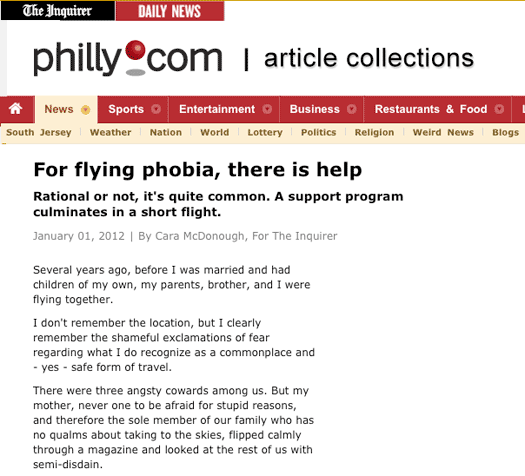 January 01, 2012|By Cara McDonough, For The Inquirer
January 01, 2012|By Cara McDonough, For The Inquirer
Several years ago, before I was married and had children of my own, my parents, brother, and I were flying together.
I don’t remember the location, but I clearly remember the shameful exclamations of fear regarding what I do recognize as a commonplace and – yes – safe form of travel. Read More>>
Conquering a Fear of Flying
By Karen Keller – AOL Family Health
Sep 8, 2010
For 25 years, Judith Kiss’ fear of flying made her avoid airports. “I’ve driven to Florida; I’ve driven to Alaska,” said Kiss, a social worker who lives in New York state.
She started suffering from claustrophobia in 1985 when she became pregnant. She said that as soon as the airplane door closed, she would panic that the plane’s ventilation system wouldn’t provide enough oxygen. Read More >>
Will Fear of Flying Hit New Heights?
By DAN CHILDS – ABC News Medical Unit
Aug. 6, 2008
A spate of highly publicized emergency aircraft landings in the past three weeks may be enough to elevate apprehension in some travelers who fear flying, psychological experts say. Read more>>
Anxiety center helps travelers beat fear of flying
Ken Valenti –
The Journal News
November 23, 2009
Phobias are bullies, and the fear of flying is a tough one. This is what I learned when I talked to Dr. Martin Seif, a psychologist, and two people who had not flown in years before taking a class in overcoming their fears. Justin Tolbert of Yonkers had flown a lot as a kid, but had been unnerved nine years ago by a severely turbulent flight home from college in Atlanta. After that, he made his trips back and forth to school “on Greyhound, driving, Amtrak, you name it,” the 27-year-old said. Read more>>
For Fear of Flying, Therapy Takes to the Skies
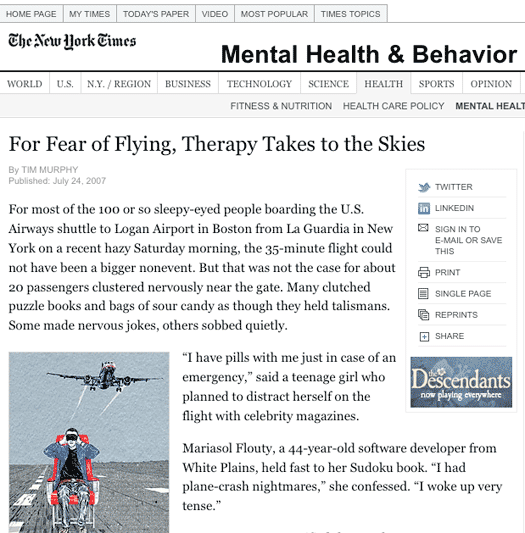
By TIM MURPHY – New York Times
Published: July 24, 2007
For most of the 100 or so sleepy-eyed people boarding the U.S. Airways shuttle to Logan Airport in Boston from La Guardia in New York on a recent hazy Saturday morning, the 35-minute flight could not have been a bigger nonevent. But that was not the case for about 20 passengers clustered nervously near the gate. Many clutched puzzle books and bags of sour candy as though they held talismans. Some made nervous jokes, others sobbed quietly. Read More >>
You’re Grounded! (But you don’t have to be)
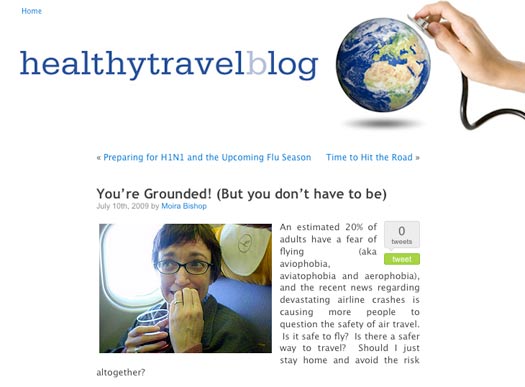
healthytravelblog
July 10th, 2009
An estimated 20% of adults have a fear of flying (aka aviophobia, aviatophobia and aerophobia), and the recent news regarding devastating airline crashes is causing more people to question the safety of air travel. Is it safe to fly? Is there a safer way to travel? Should I just stay home and avoid the risk altogether? Read More >>
Letter to the Editor – New York Times
Published: October 1, 2006
Your article about nervous fliers portrays the medical management of post-9/11 flight fright. But anti-anxiety medication by itself cannot overcome the fear of flying for the majority of flight phobics. Read More >>
Comments from formerly fearful fliers
Here is what formerly fearful fliers say:
Just want to wish you “Happy holidays”! Twenty plus flights under my belt since I took the course! We are flying to MD next week…then FLA in February, and Puerto Rico in the Spring. Thank you! —Jessica
I flew up and back to Boston this weekend. Prior to this, I suffered terribly from claustrophobia and could not fly for five years. I had sought treatment for my claustrophobia through different therapists and cognitive therapy organizations. I would like to commend Dr. Martin Seif, who…helped me understand my claustrophobia and how to deal with it. —Dorothy
I feel as if I am in paradise. Perfect weather and beautiful views. It took 20 years to return to Hawaii. I handled the flight well and look forward to the return flight. Thank you for making this possible. Aloha. —Laurie
“I attended your flying classes a couple of years ago. I had been deeply phobic for many years, and I was certain that I would never be able to travel by air. Today I fly on a regular basis. It is one of the greatest triumphs of my life.”–Richard


